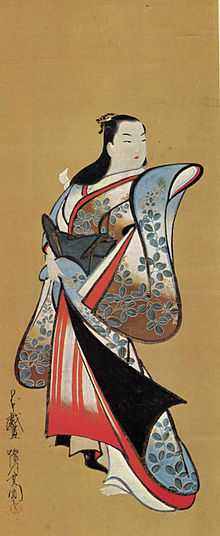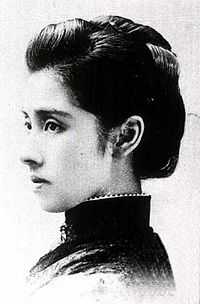Bijin

Bijin (美人) is a Japanese term which literally means "a beautiful person".
Meaning
However, in practice this term means "beautiful woman" because of kanji character bi (美) which has a feminine connotation.[1]
Bijin can also simply mean "(a) beauty"; in a modern and informal context it means "a doll". Bijins are usually beautiful, charming and harmonious women, who wear pretty clothes.
In Mandarin Chinese, 美人 (Pinyin: měirén) also means "a beautiful woman".[2]
Bijin in Japanese art
Pictures of bijins in Japanese art are called bijinga. Bijinga is described as a genre of ukiyo-e paintings.
Some of the greates bijinga artists are Utamaro, Suzuki Harunobu and Torii Kiyonaga.[3]
Until the beginning of the 20th century, bijinga was really popular.
Famous bijin women
Akita, located on Honshu, in northern Japan, is famous for its "bijins of Akita"[4] which are characterized by their round face, clear skin[5] and high-pitched voice.
Ono no Komachi, one of the Thirty-six Immortals of Poetry, was a beauty from Akita.[6]
Fukuoka, the largest city of Kyushu island in southern Japan, is also known for a large population of bijins.[7]
Some of Utamaro's favourite models have remained bijin famous; for example Naniwaya Okita (fr), a courtesan Hanaōgi (fr), Tomimoto Toyohina (fr) and Takashima Ohisa.[8]
-

Bijinga by Kitagawa Utamaro ("Flowers of Edo: Young Woman's Narrative Chanting to the Samisen", c. 1800).
-

Mutsu Ryōko (Mutsu Munemitsu's wife).
References
Notes
- ↑ Translation of kanji character 美
- ↑ Translation of 美人 in Mandarin Chinese
- ↑ Tadashi Kobayashi, Utamaro: Portraits from the Floating World, pages 89-92
- ↑ Le Petit Futé : Les bijin d'Akita, page 379 (in French)
- ↑ Chris Rowthorn, Ray Bartlett, Andrew Bender, Michael Clark, Matthew D. Firestone, Wendy Yanagihara, Lonely Planet, Japan, page 543
- ↑ The Woman Without a Hole - & Other Risky Themes from Old Japanese, page 173
- ↑ Chris Rowthorn, Ray Bartlett, Andrew Bender, Michael Clark, Matthew D. Firestone, Wendy Yanagihara, Lonely Planet, Japan, page 666
- ↑ Images du Monde Flottant - Peintures et estampes japonaises XVIIe - XVIIIe siècles, pages 300-305 (in French)
Bibliography
- Images du Monde Flottant - Peintures et estampes japonaises XVIIe - XVIIIe siècles. (Septembre 2004) (ISBN 2-7118-4821-3)
See also
- Bijin-ga
- Bihaku
- Bishoujo
